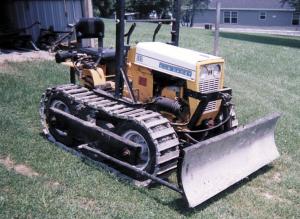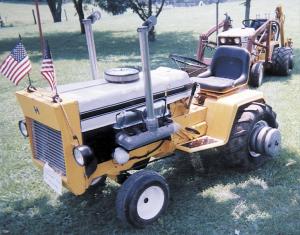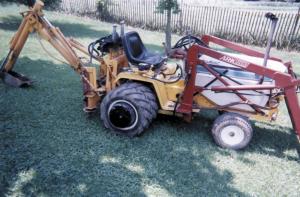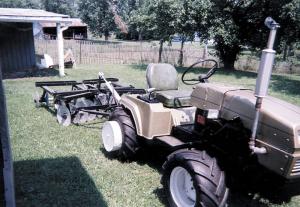"Chopped" Garden Tractors Rebuilt For Heavy Work
Guys who chop motorcycles to make them something more than came off the factory floor have nothing on Loren Arledge. He chops garden tractors to customize them and builds his own loaders, backhoes, trenchers, forklifts and other implements.
What's remarkable about the several tractors that Arledge has built and rebuilt is the quality. He takes the time to do things right. "It took five years to build a backhoe," says Arledge, who also put a loader on the tractor. "The loader is Allis Chalmers. They said it couldn't be mounted on the Cub, but I did it."
The secret to how he hangs such heavy implements on garden tractor frames is the way he holds 4-in. channel irons to the bottom of the frame. On the 160, they form the base for both loader and backhoe. At the back end of the tractor, an upright frame mounted to the base supports the cylinders and arms. Sections of 4-in. pipe form the arms of the backhoe, and hydraulic cylinders on the sides of the frame push outriggers into the ground. This lifts the wheels off the ground, stabilizing it during a dig.
Arledge organized the control valves for the various cylinders in a row on top of the rear uprights. To access them, he adapted his seat so it would swivel around. This allows him to face the backhoe and rest his feet on the outrigger cylinders.
To mount the loader, Arledge welded a 4-in. sq. tube across the channel irons bolted to the frame and midway between the front and back wheels. Support braces also extend to the front end of the tractor frame.
The channel iron supports also extend out in front of the tractor frame. A 10-in. channel iron welds across them just ahead of the tractor. A 3 by 10-in. plate is welded to it and provides a base for the hydraulic pump. The oil reservoir is attached to a side arm of the loader.
Even after all of that, Arledge wasn't done. "I put duals on the Cub to carry the backhoe by welding pieces of steel tubing to the back wheels and then welding plates on them to bolt the second set of wheels."
Another one of his tractors is a Cub 122 with a dozer blade and tracks. He used an International rear end with a creeper gear, perfect for slow turns when pushing a big load.
He first beefed up the frame with 4-in. channel iron. To make room for the tracks, he had to extend the wheels away from the sides of the Cub. Arledge found front and back axle hubs from a car that matched up to the Cub Cadet axles. He also extended the axles to make room for cog gears beyond the wheels. A chain from the rear drive cog gear carries power to the front axle, making the Cub all-wheel drive. Original disk brakes on the front axle controlled by levers on each side and regular foot brakes on the rear allow Arledge to pivot the dozer as needed.
The tracks themselves are made from 2-in. angle iron welded to 2-in. iron plates to form treads.
On another project, Arledge took parts from two tractors and built an articulated one. In another case, he rebuilt a garden tractor to attach to a trencher.
He also took parts from two tractors and extended one frame 10 in. so he could install a V-8 engine. He had to fashion a new frame around an old car radiator and make a new hood to fit the engine and hold an air cleaner and carburetor. He kept the transmission and drive train from the original Cub Cadet.
"When we hooked up the transmission, we realized we had three gears reverse and one forward," says Arledge. "The Cub drives forward, but the V-8 drives backward, so I had to reverse the pinion gear."
Arledge also bolted a plate to the V-8 flywheel and bolted the clutch plate to that to keep it from flying off.
"We don't run it fast," he says. "I have a screw on the floorboard that keeps the throttle from going down too far. It would be dangerous to run it wide open."
Contact: FARMSHOW Followup, Loren Arledge, 245 State Route 207, Chillicothe, Ohio 45601 (ph 740 775-7876).

Click here to download page story appeared in.
Click here to read entire issue
"Chopped" Garden Tractors Rebuilt For Heavy Work TRACTORS Modifications 27-6-25 Guys who chop motorcycles to make them something more than came off the factory floor have nothing on Loren Arledge. He chops garden tractors to customize them and builds his own loaders, backhoes, trenchers, forklifts and other implements.
What's remarkable about the several tractors that Arledge has built and rebuilt is the quality. He takes the time to do things right. "It took five years to build a backhoe," says Arledge, who also put a loader on the tractor. "The loader is Allis Chalmers. They said it couldn't be mounted on the Cub, but I did it."
The secret to how he hangs such heavy implements on garden tractor frames is the way he holds 4-in. channel irons to the bottom of the frame. On the 160, they form the base for both loader and backhoe. At the back end of the tractor, an upright frame mounted to the base supports the cylinders and arms. Sections of 4-in. pipe form the arms of the backhoe, and hydraulic cylinders on the sides of the frame push outriggers into the ground. This lifts the wheels off the ground, stabilizing it during a dig.
Arledge organized the control valves for the various cylinders in a row on top of the rear uprights. To access them, he adapted his seat so it would swivel around. This allows him to face the backhoe and rest his feet on the outrigger cylinders.
To mount the loader, Arledge welded a 4-in. sq. tube across the channel irons bolted to the frame and midway between the front and back wheels. Support braces also extend to the front end of the tractor frame.
The channel iron supports also extend out in front of the tractor frame. A 10-in. channel iron welds across them just ahead of the tractor. A 3 by 10-in. plate is welded to it and provides a base for the hydraulic pump. The oil reservoir is attached to a side arm of the loader.
Even after all of that, Arledge wasn't done. "I put duals on the Cub to carry the backhoe by welding pieces of steel tubing to the back wheels and then welding plates on them to bolt the second set of wheels."
Another one of his tractors is a Cub 122 with a dozer blade and tracks. He used an International rear end with a creeper gear, perfect for slow turns when pushing a big load.
He first beefed up the frame with 4-in. channel iron. To make room for the tracks, he had to extend the wheels away from the sides of the Cub. Arledge found front and back axle hubs from a car that matched up to the Cub Cadet axles. He also extended the axles to make room for cog gears beyond the wheels. A chain from the rear drive cog gear carries power to the front axle, making the Cub all-wheel drive. Original disk brakes on the front axle controlled by levers on each side and regular foot brakes on the rear allow Arledge to pivot the dozer as needed.
The tracks themselves are made from 2-in. angle iron welded to 2-in. iron plates to form treads.
On another project, Arledge took parts from two tractors and built an articulated one. In another case, he rebuilt a garden tractor to attach to a trencher.
He also took parts from two tractors and extended one frame 10 in. so he could install a V-8 engine. He had to fashion a new frame around an old car radiator and make a new hood to fit the engine and hold an air cleaner and carburetor. He kept the transmission and drive train from the original Cub Cadet.
"When we hooked up the transmission, we realized we had three gears reverse and one forward," says Arledge. "The Cub drives forward, but the V-8 drives backward, so I had to reverse the pinion gear."
Arledge also bolted a plate to the V-8 flywheel and bolted the clutch plate to that to keep it from flying off.
"We don't run it fast," he says. "I have a screw on the floorboard that keeps the throttle from going down too far. It would be dangerous to run it wide open."
Contact: FARMSHOW Followup, Loren Arledge, 245 State Route 207, Chillicothe, Ohio 45601 (ph 740 775-7876).
To read the rest of this story, download this issue below or click
here to register with your account number.










